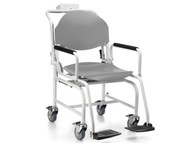Body weight is a key assessment tool in medical care.
Whether it's for direct usage such as the calculation of a medication dosage, or an indirect measure of a person's overall wellbeing, accurate weight measurement cannot be underestimated!
This article provides a quick overview, assisting care staff and family members in selecting the most appropriate weighing equipment and the best practises for their use.
When selecting an appropriate type of scale, please consider the patient's clinical condition and level of mobility. Specialised devices such as bed scales, chair scales, wheelchair scales or hoist/lifter scales can reduce staff workload and increase the patient's comfort and safety.

Different countries may have different regulations and requirements but, generally speaking, it is recommended that medical scales have a Class III level of accuracy, even if it is not technically required by the government.
All weigh scales should be regularly checked (6 monthly intervals are recommended) for accuracy.
Before measurement
- If there is a bubble level indicator, rotate adjustment feet to ensure platform is level
- Catheter bags & other drainage devices to be emptied before measurement or use tare function to remove weight
- Scale should be placed on hard, flat surface
- Scale should not touch wall or surrounding furniture
- Scale should be set to zero before use
- Clean scale before use (typically, parts that the patient will contact) with alcohol wipes to minimise infection risk
- Remove heavy clothing from patient. If tare function is available it can be used instead to deduct clothing weight
General tips for measurement
Stand-on Floor Scales
- Ensure patient is standing upright and not supporting their weight by leaning against a wall, furniture, or a walking aid (exception applies for handrail scales that are designed to support patient weight without affecting accuracy)
Chair Scales
- Ensure chair scale is not moving, with brakes engaged
- Ensure patient's feet are positioned on the footrests and not on the floor
- Shoes/slippers are not required - alternatively if scale has pre-tare function, footwear weight can be deducted
- Check pockets and hands and remove any items that may contribute to the patient's weight
Wheelchair Scales
- Record weight of empty wheelchair . Alternatively, if scale has pre-tare function, wheelchair weight deduction can be saved into scale memory for future use
- Push wheelchair with patient sitting in it onto scale platform. For safety reasons, patient's feet should be positioned on the footrests, although this will not affect measurement accuracy
Lifter/Hoist Scales
- Ensure that scale and lift system are compatible
- Check that sling is suitable size for patient
- If tare function is available, it can be used to deduct sling weight
- Ensure patient's clothing and other objects are not caught in sling
- Ensure patient is lifted entirely off the ground
Patient Transfer Scale
- Ensure that if patient's body exceeds size of scale, they are not touching the ground/wall
Infant Scales
- Ensure infant is placed entirely on measurement tray
Related Products
9th Dec 2024

